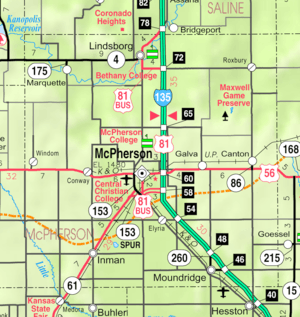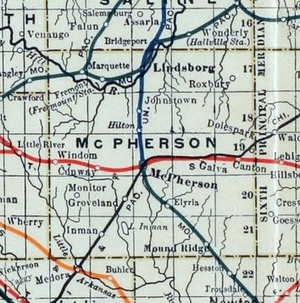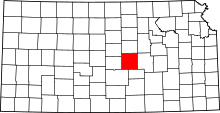Moundridge, Kansas
| Moundridge, Kansas | |
|---|---|
| City | |
 Location within McPherson County and Kansas | |
 KDOT map of McPherson County (legend) | |
| Coordinates: 38°12′9″N 97°31′7″W / 38.20250°N 97.51861°WCoordinates: 38°12′9″N 97°31′7″W / 38.20250°N 97.51861°W | |
| Country | United States |
| State | Kansas |
| County | McPherson |
| Township | Mound |
| Incorporated | 1887 |
| Government | |
| • Type | Mayor–Council |
| Area[1] | |
| • Total | 1.41 sq mi (3.65 km2) |
| • Land | 1.41 sq mi (3.65 km2) |
| • Water | 0 sq mi (0 km2) |
| Elevation | 1,493 ft (455 m) |
| Population (2010)[2] | |
| • Total | 1,737 |
| • Estimate (2015)[3] | 1,696 |
| • Density | 1,200/sq mi (480/km2) |
| Time zone | CST (UTC-6) |
| • Summer (DST) | CDT (UTC-5) |
| ZIP code | 67107 |
| Area code | 620 |
| FIPS code | 20-48800 [4] |
| GNIS feature ID | 0477748 [5] |
| Website | Moundridge.com |
Moundridge is a city in McPherson County, Kansas, United States. As of the 2010 census, the city population was 1,737.[6] The city is named for the settlement that became the incorporated city in 1887 located in Mound Township.
History

Early history
For many millennia, the Great Plains of North America was inhabited by nomadic Native Americans. From the 16th century to 18th century, the Kingdom of France claimed ownership of large parts of North America. In 1762, after the French and Indian War, France secretly ceded New France to Spain, per the Treaty of Fontainebleau.
19th century
In 1802, Spain returned most of the land to France. In 1803, most of the land for modern day Kansas was acquired by the United States from France as part of the 828,000 square mile Louisiana Purchase for 2.83 cents per acre.
In 1854, the Kansas Territory was organized, then in 1861 Kansas became the 34th U.S. state. In 1867, McPherson County was established within the Kansas Territory, which included the land for modern day Moundridge.
In 1876, the community was founded with the name Christian. In 1887, it was renamed Moundridge after the elevation of the town site.[7]
The Moundridge area was settled by Mennonites soon after the completion of the transcontinental railroad in 1869. The museums in nearby Hillsboro and Goessel demonstrate the lives and times of these early settlers.
Between 1874 and 1880, of the approximately 45,000 Mennonites who had been living in South Russia, 10,000 departed for the United States and 8,000 for Manitoba. Available cropland in the central United States was similar to that in their homelands in the Crimean Peninsula. Since the central part of the state was settled, Kansas has enjoyed the reputation as the top wheat-producing state. Settlers in central Kansas, experienced in Russian methods of dryland farming and flour milling, introduced winter wheat in 1873 and quickly saw their industry become dominant.
Language
Virtually all of the original settlers of McPherson County spoke German, many exclusively. With the coming of the automobile and the importance of commercial participation with the English-speaking citizens, the use of German diminished in importance. The participation of the United States in World War I and II dramatically increased the use of English and by the early 1940s, ministers rarely preached in German. As of the year 2000, a very small number of German religious publications are available, primarily for use by elderly congregants.
Geography
Moundridge is located at 38°12′9″N 97°31′7″W / 38.20250°N 97.51861°W (38.202497, -97.518506).[8] According to the United States Census Bureau, the city has a total area of 1.41 square miles (3.65 km2), all of it land.[1]
Demographics
| Historical population | |||
|---|---|---|---|
| Census | Pop. | %± | |
| 1890 | 443 | — | |
| 1900 | 557 | 25.7% | |
| 1910 | 626 | 12.4% | |
| 1920 | 733 | 17.1% | |
| 1930 | 870 | 18.7% | |
| 1940 | 864 | −0.7% | |
| 1950 | 942 | 9.0% | |
| 1960 | 1,214 | 28.9% | |
| 1970 | 1,271 | 4.7% | |
| 1980 | 1,453 | 14.3% | |
| 1990 | 1,531 | 5.4% | |
| 2000 | 1,593 | 4.0% | |
| 2010 | 1,737 | 9.0% | |
| Est. 2015 | 1,696 | [3] | −2.4% |
| U.S. Decennial Census | |||
2010 census
As of the census[2] of 2010, there were 1,737 people, 736 households, and 461 families residing in the city. The population density was 1,231.9 inhabitants per square mile (475.6/km2). There were 803 housing units at an average density of 569.5 per square mile (219.9/km2). The racial makeup of the city was 96.9% White, 0.3% African American, 0.4% Native American, 0.1% Asian, 0.9% from other races, and 1.3% from two or more races. Hispanic or Latino of any race were 3.4% of the population.
There were 736 households of which 25.7% had children under the age of 18 living with them, 49.7% were married couples living together, 8.8% had a female householder with no husband present, 4.1% had a male householder with no wife present, and 37.4% were non-families. 33.6% of all households were made up of individuals and 19.4% had someone living alone who was 65 years of age or older. The average household size was 2.25 and the average family size was 2.85.
The median age in the city was 46.6 years. 21.6% of residents were under the age of 18; 6% were between the ages of 18 and 24; 20% were from 25 to 44; 24.9% were from 45 to 64; and 27.6% were 65 years of age or older. The gender makeup of the city was 46.1% male and 53.9% female.
2000 census
As of the census[4] of 2000, there were 1,593 people, 647 households, and 419 families residing in the city. The population density was 1,519.6 people per square mile (585.8/km²). There were 681 housing units at an average density of 649.6 per square mile (250.4/km²). The racial makeup of the city was 97.24% White, 0.50% African American, 0.88% Native American, 0.06% Asian, 0.75% from other races, and 0.56% from two or more races. Hispanic or Latino of any race were 1.51% of the population.[9][10]
There were 647 households out of which 28.7% had children under the age of 18 living with them, 58.0% were married couples living together, 4.9% had a female householder with no husband present, and 35.1% were non-families. 31.2% of all households were made up of individuals and 17.2% had someone living alone who was 65 years of age or older. The average household size was 2.31 and the average family size was 2.90.
In the city the population was spread out with 22.5% under the age of 18, 6.6% from 18 to 24, 24.9% from 25 to 44, 19.6% from 45 to 64, and 26.4% who were 65 years of age or older. The median age was 42 years. For every 100 females there were 87.9 males. For every 100 females age 18 and over, there were 85.4 males.
The median income for a household in the city was $37,644, and the median income for a family was $44,934. Males had a median income of $34,038 versus $20,223 for females. The per capita income for the city was $19,263. About 2.1% of families and 4.7% of the population were below the poverty line, including 5.0% of those under age 18 and 7.5% of those age 65 or over.
Education
Primary and secondary education
Moundridge is part of Unified School District 423.[11][12]
Infrastructure
Transportation
Interstate I-135 runs along the north-east side of the city. Highway US 81 passes through city.
Moundridge Municipal Field is located approximately 1 mile (1.6 km) east of central Moundridge.
Utilities
- Internet
- Wireless is provided by Pixius Communications.
- Satellite is provided by HughesNet, StarBand, WildBlue.
- TV
- Satellite is provided by DirecTV, Dish Network.
- Terrestrial is provided by regional digital TV stations.
- Electricity
- City is provided by City of Moundridge.
- Natural Gas is provided by City of Moundridge.
- Water
- City is provided by City of Moundridge.
- Rural is provided by Marion County RWD #4.
- Sewer is provided by City of Moundridge.
- Trash is provided by McPherson Area Solid Waste Utility.
Notable people
- Laurie Koehn, professional basketball player
See also
Further reading
- A Centennial Commemoration, Eden Mennonite Church, Moundridge, Kansas, Zur Ehre Gottes To the Glory of God 1895 - 1995; Eden Mennonite Church; 1998.
- Century One: History of Moundridge, Kansas, 1887-1987; Moundridge Centennial Committee; Mennonite Press; 1987.
- A Pictorial Review - Moundridge, Kansas 1887-1962; Moundridge Journal, 1962.
- Moundridge Golden Jubilee, 1887-1937; Moundridge Journal; Oct. 7, 1937.
References
- 1 2 "US Gazetteer files 2010". United States Census Bureau. Retrieved 2012-07-06.
- 1 2 "American FactFinder". United States Census Bureau. Retrieved 2012-07-06.
- 1 2 "Annual Estimates of the Resident Population for Incorporated Places: April 1, 2010 to July 1, 2015". Retrieved July 2, 2016.
- 1 2 "American FactFinder". United States Census Bureau. Retrieved 2008-01-31.
- ↑ "US Board on Geographic Names". United States Geological Survey. 2007-10-25. Retrieved 2008-01-31.
- ↑ "2010 City Population and Housing Occupancy Status". U.S. Census Bureau. Retrieved March 6, 2011.
- ↑ Kansas State Historical Society (1916). Biennial Report of the Board of Directors of the Kansas State Historical Society. Kansas State Printing Plant. p. 232.
- ↑ "US Gazetteer files: 2010, 2000, and 1990". United States Census Bureau. 2011-02-12. Retrieved 2011-04-23.
- ↑ U.S. Census Bureau - 2000 Census, Population and Housing Unit Counts for Kansas
- ↑ U.S. Census Bureau - 1990 Census, Population and Housing Unit Counts for Kansas
- ↑ USD 423
- ↑ Kansas School District Boundary Map
External links
| Wikimedia Commons has media related to Moundridge, Kansas. |
- City
- Schools
- USD 423, local school district
- USD 423 School District Boundary Map, KDOT
- Historical
- Moundridge history
- Eden Mennonite Church history
- Historic Images of Moundridge, Special Photo Collections at Wichita State University Library
- Maps
- Moundridge City Map, KDOT
